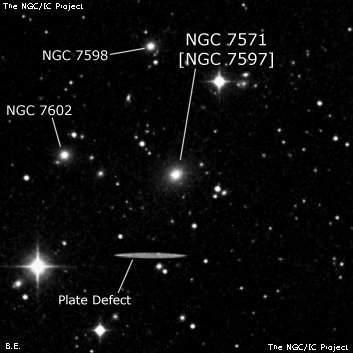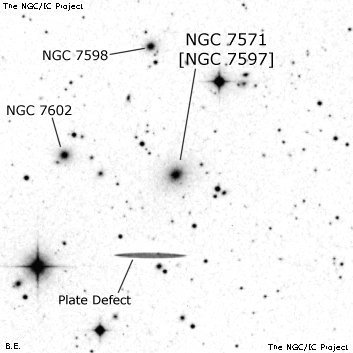NGC/IC Project Restoration Effort
(This is a very very beta version)
NGC7571


Basic Information
Location and Magnitude
Right Ascension: 23:18:30.3
Declination: +18:41:18
Constellation: PEG
Visual Magnitude: 14.0
Historic Information
Discoverer: Schultz
Year of discovery: 1867
Discovery aperture: 9.6
Observational
Summary description: vF, cE, sev knots or gr of neb
Sub-type: S0
Corwin's Notes
=====
NGC 7571 may be NGC 7597. Or it may be NGC 7578. Or maybe not. Here is
Schultz's entire note from page 103 of his 1874 monograph on the object (I've
expanded his abbreviations):
"A poor stellar group of pretty bright stars follows the above nebulae
[N7547, N7549, and N7550] about 1 1/2 minutes; and the whole region
following this stellar group seems nebulous: [Schultz italics] a group of
small nebulae or a considerably extended nebulosity with several knots? [end
italics] As yet the sky was not sufficiently dark, and the nebulosity very
faint and indistinct, no decision could be arrived at. This nebulosity
independently remarked in the autumns 1867 and 1869, as on the second
occasion the elder notice was forgotten. Description and position do not at
all agree with III. 181 [N7550]!"
There is no such group of bright stars 1.5 minutes following the N7550 galaxy
group. The stellar group is instead 1.5 minutes of time following NGC 7578
(coincidentally, RNGC makes N7571=N7578; it probably isn't unless Schultz got
his direction wrong and the nebulosity is PRECEDING the stellar group). But
Schultz would have had to misidentify N7578 as N7547 or N7550. This, I admit,
is a bit of a stretch. But the group of stars is 3.3 minutes following the
N7550 group, as well as nearly 20 arcmin to the south. Schultz would probably
have been aware of that considerable difference.
Scattered around through the bright stars are several galaxies, four of which
(N7588, N7597, N7598, and N7602) Marth ran across about the same time using
Lasalle's great telescope in Malta. These are bright enough that Schultz
could have pulled them out with his 9.6-inch.
So, I've tentatively put NGC 7571 on the brightest of Marth's galaxies, N7597.
The other possibility is that of RNGC's: N7571 is the same as N7578. N7578
is double and is the brightest in a tight group of galaxies (Hickson 94).
This would be in accord with Schultz's description of his object as possibly
being a group of nebulae. However, it also requires Schultz to make a mistake
in his directions. Also, N7578 is considerably fainter than N7550 or N7597 --
but either of these hypotheses requires that Schultz saw N7578.
I'm leaning slightly toward the N7597 hypothesis, but the other could well be
the correct one.
-----
On a somewhat more practical level, Schultz left us no position for NGC 7571,
so I suppose that Dreyer himself worked it out for the GC Supplement. This
was copied correctly into the NGC. Bigourdan provides a "corrected" RA in the
IC2 Notes, but he observed a double star at 23 17 10.6, +18 58 02 (J2000,
UCAC) not the kind of object that would match Schultz's rather unusual
description.
Wolfgang adopted Bigourdan's double in his 1997 list of NGC objects, though in
his 2010 book, makes the object identical with NGC 7597. This may be as good
an identification as any other, but I am still skeptical given the problems in
Schultz's note. So, the question marks that I put on this earlier stay firmly
in place.
And then I looked at NGC 7578 again -- "... a group of small nebulae or a
considerably extended nebulosity with several knots?" That seems to describe
N7578 and its accompanying nebulae and stars pretty well. So, is this
Schultz's mystery object? See the last two sentences of the previous
paragraph!
Steve's Notes
=====
NGC 7571
See observing notes for NGC 7597. =**?, Bigourdan and Reinmuth. =NGC 7578, RNGC.



